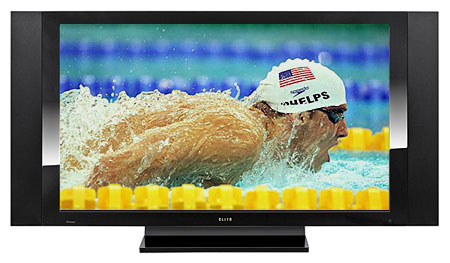Pioneer Elite PRO-111FD Plasma TV

Now comes 9G, the last generation of Kuro to be made entirely by Pioneer—the raw panels for all future models will be outsourced to Panasonic. Whether or not the TVs manufactured around those panels will equal or even surpass the Pioneer-built models remains to be seen. For the moment, let's see how 9G stacks up.
Like last year's models, there are two lines of 9G Kuros—Pioneer and Elite. (Actually, there will be a third line later this year, dubbed Signature Series, comprised of video monitors with no audio, TV tuner, or table-top stand.) For this review, I looked at the 50-inch Elite PRO-111FD, the direct descendant of the Pioneer Elite PRO-110FD I reviewed in March 2008. These two models share many of the same features and characteristics, so I'll concentrate on the differences here, though I will also reiterate some of the most important commonalities.
Features
Physically, the PRO-111FD and 110FD are virtually identical, with fairly large piano-black bezels. The new cabinet is a bit slimmer, and the back- and side-panel connections have changed a bit—for example, the side-panel component input has been replaced with one of the four HDMI inputs, leaving only one component input on the back. Both have detachable speakers on the side, making the cabinet quite wide.
As before, the PRO-111FD has an Optimum Mode that automatically adjusts many parameters based on the image content and ambient-light conditions. The new model includes a detachable sensor that detects the color of any ambient light. In addition, you can call up a display at the bottom of the screen that reveals the status of the measurements and parameter settings in real time, which is pretty slick. Still, I much prefer to leave all that automatic felgercarb off and manually adjust the TV for optimum performance.
Like the 8G models, the picture and audio controls in this year's offerings are associated with the AV modes, not inputs, which is unfortunate. For example, if you adjust the Pure AV mode for one input and apply it to another input, the control settings are the same. The only exception is the Standard mode, which can be set up independently for each input.
It bears repeating that all Pioneer TVs have the ability to display 1080p/24 at 72Hz, repeating each frame three times. This avoids 3:2 pulldown altogether and results in much smoother motion on film-based material. I know of no other flat panels with this rare and important feature.
Also available are three deinterlacing modes for 480i and 1080i signals. Standard mode reassembles the original film frames and displays them in a 3:2 cadence at 60Hz (a procedure called "inverse telecine"), while Advance mode does the same thing but displays each frame three times at a display rate of 72Hz, avoiding 3:2 pulldown. Smooth mode reassembles the original film frames and interpolates new frames between them as needed to achieve a display rate of 60Hz.
One key feature is Home Media Gallery, which allows the TV to access audio and video files stored on networked servers, such as Windows and Macintosh computers, other DLNA (Digital Living Network Alliance) servers, and USB storage devices. To take advantage of Home Media Gallery, you connect the TV's Ethernet port to your home router; you can also connect a storage device to the USB port on the side panel. Unlike 8G, which limited Home Media Gallery to the Elite line, this feature is available on all 9G sets in the Elite and Pioneer lines.
Any Windows computer you want to supply content must be running Windows Media Player 11 (or another DLNA server program), which must be configured to allow file sharing with the TV. Macs can also join the party by running DLNA server software such as TwonkyMedia.
Unique to the Elite line—and, presumably, the upcoming Reference monitors—are ISF Day and Night modes, which can be calibrated only from the service menu or by using special software developed by Sencore. These modes let a calibrator lock in the calibration so they can't be messed up by inveterate but unskilled tweakers.
- Log in or register to post comments




















































